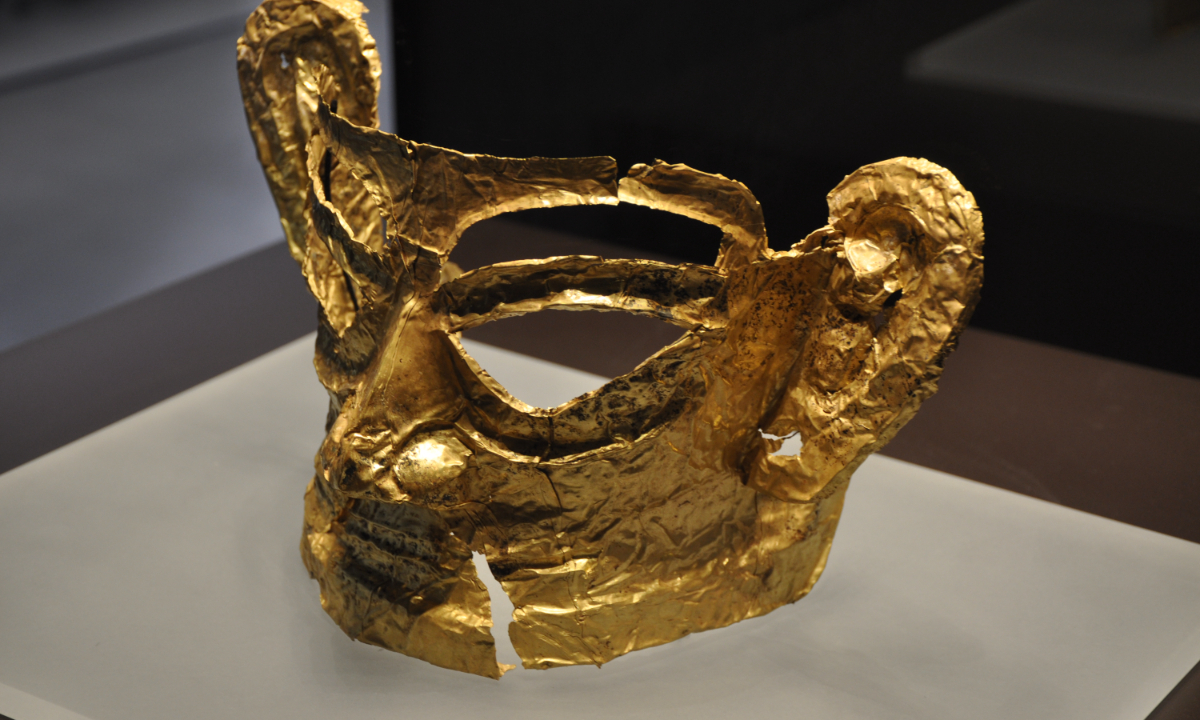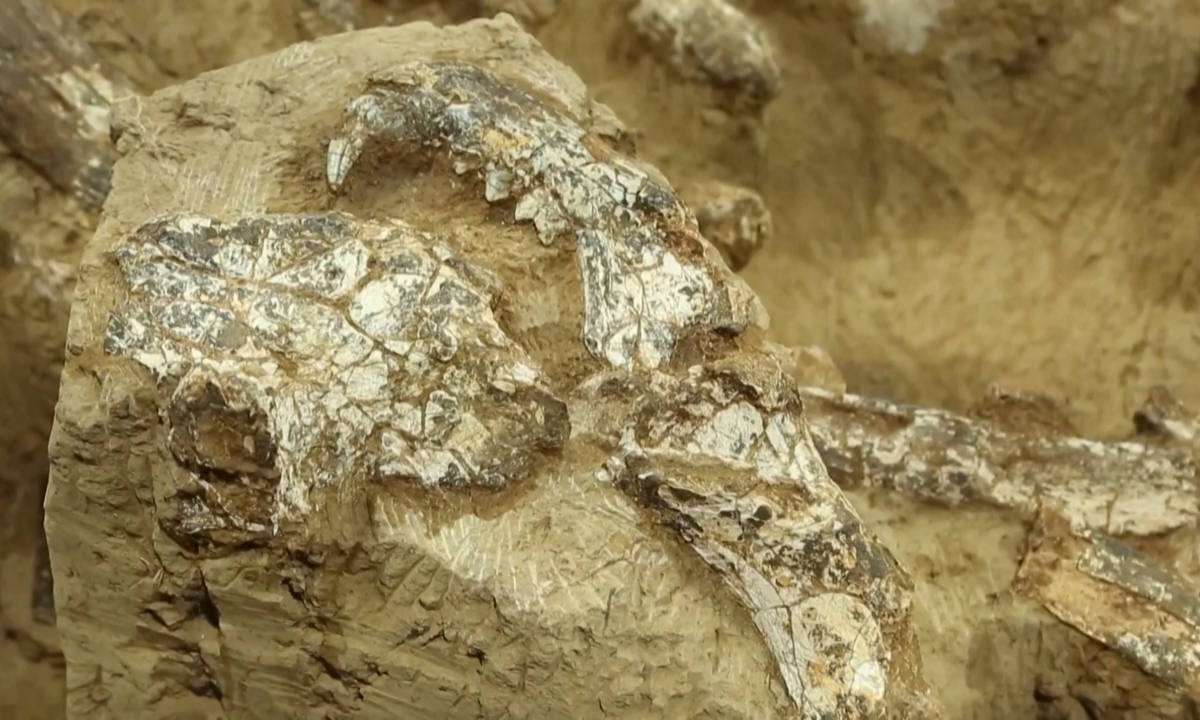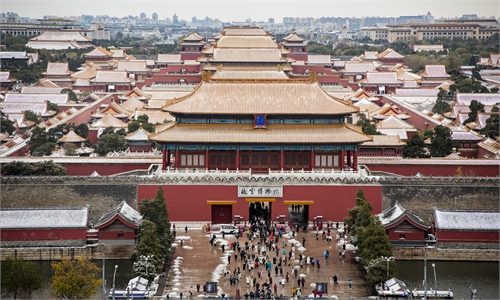Mysterious Sanxingdui masks, 3D models, shipwrecks – highlights of Chinese archaeology in 2022
Editor's Note:
As we are about to bid farewell to the year 2022, a year where we lived through happiness, accomplishments and joy although life was accompanied by a pandemic, the Global Times staff of life and culture will share our observations on the cultural life of the whole year to offer a platform to remember what the country has accomplished in the cultural sector and the cultural life that we, the ordinary people, have enjoyed, and to help everyone get ready to embrace the New Year with hope and strength.

From the mysterious ancient Shu Culture that emerged from the Sanxingdui Ruins to a Qing Dynasty (1644-1911) shipwreck salvaged from a riverbed where it had been laying for more than a century and a half... various discoveries were made by thousands of hard working Chinese archaeologists and workers in 2022.
Having covered these achievements in Chinese archaeology, we at the Global Times were impressed with how advanced technology such as 3D scanning and AI repair is being used in the field and how new young talents educated in multiple disciplines have expanded the depth and breadth of research.
We have also taken note of how China's archaeological finds are capturing the attention of the public, especially among young people whose fascination with these new discoveries have pushed them to become trending topics on social media.
Experts agree that advanced technology and public enthusiasm for archaeology have been important sources of support for the development of the field in China, which can be seen in 2022's great archaeological discoveries.
Means in modern times
Chinese President Xi Jinping has called for the development of archaeology with Chinese features, style and ethos, according to a Xinhua report. Generations of archaeologists have made a series of major discoveries through tireless efforts, playing an important role in making Chinese civilization better understood, Xi noted, adding that these discoveries have highlighted the great contributions Chinese civilization has made to civilizations around the world.

With support from the central government, Chinese archaeologists have been developing diverse methods to improve excavation and research, in which technology is an essential part.
Can you imagine an intelligent robot with 360-degree flexible motion that can identify more than 10 types of burial remains? Can you imagine a giant ancient shipwreck, weighing thousands of tons, being lifted out of the water and then transported to a research facility in a whole?
These scenes that once had been impossible to imagine have been accomplished again and again at different sites.
Nearly 13,000 cultural relics, including many never-before-seen items, were unearthed from six pits at the Sanxingdui Ruins, presenting a closer and complete view of the culture of the ancient Shu Kingdom, dating back of 4,800 to 2,600 years ago.
The great discoveries from the site announced in June stunned the world, as did the technology used to help understand their place in the history of China.
Many cultural relics were unearthed as fragments, but were reassembled through AI technology such as 3D modeling and image recognition, Ding Daoshi, a veteran analyst in the AI sector who visited the excavation site at the Sanxingdui Ruins, told the Global Times.

Researchers took 360-degree high-resolution images of these relics, which were then fed into a program that gave suggestions on how they fit together. Researchers could then put them together as efficiently as if they were building with blocks, Ding introduced.
Besides the Sanxingdui Ruins, high-technology has been used in numerous other archaeological projects. China's digital archaeology with the application of UAV ultra-low altitude photography and 3D reconstruction technology is leading the world, experts such as Chen Xianglong, a research fellow at the Chinese Academy of Social Sciences' Institute of Archeology, noted.
New blood
In 2022, different archaeological research institutes around China published reports on a number of new discoveries such as an ancient human skull that dates back to around 1 million years ago and splendid stone carvings dating back to the Tang Dynasty (618-907).
Most of these ended up trending on Chinese social media platforms such as Sina Weibo as soon as they were published.
In November, the livestream of the salvage operation of an incredibly well-preserved Qing Dynasty shipwreck from the bottom of the Yangtze River gained tens of millions of views on Sina Weibo.
More young people have been willing to study archaeology at colleges. For instance, the School of Archaeology at Jilin University currently enrolls about 60 students every year, according to a report from the Xinhua News Agency.
This increase of young talents attracted to archaeology are sure to become a solid foundation for the field, as the experts say.
As we are about to bid farewell to the year 2022, a year where we lived through happiness, accomplishments and joy although life was accompanied by a pandemic, the Global Times staff of life and culture will share our observations on the cultural life of the whole year to offer a platform to remember what the country has accomplished in the cultural sector and the cultural life that we, the ordinary people, have enjoyed, and to help everyone get ready to embrace the New Year with hope and strength.

A research base for Yangtze River Estuary No.2 shipwreck in Shanghai Photo: VCG
From the mysterious ancient Shu Culture that emerged from the Sanxingdui Ruins to a Qing Dynasty (1644-1911) shipwreck salvaged from a riverbed where it had been laying for more than a century and a half... various discoveries were made by thousands of hard working Chinese archaeologists and workers in 2022.
Having covered these achievements in Chinese archaeology, we at the Global Times were impressed with how advanced technology such as 3D scanning and AI repair is being used in the field and how new young talents educated in multiple disciplines have expanded the depth and breadth of research.
We have also taken note of how China's archaeological finds are capturing the attention of the public, especially among young people whose fascination with these new discoveries have pushed them to become trending topics on social media.
Experts agree that advanced technology and public enthusiasm for archaeology have been important sources of support for the development of the field in China, which can be seen in 2022's great archaeological discoveries.
Means in modern times
Chinese President Xi Jinping has called for the development of archaeology with Chinese features, style and ethos, according to a Xinhua report. Generations of archaeologists have made a series of major discoveries through tireless efforts, playing an important role in making Chinese civilization better understood, Xi noted, adding that these discoveries have highlighted the great contributions Chinese civilization has made to civilizations around the world.

A golden mask from the Sanxingdui Ruins Photo: VCG
With support from the central government, Chinese archaeologists have been developing diverse methods to improve excavation and research, in which technology is an essential part.
Can you imagine an intelligent robot with 360-degree flexible motion that can identify more than 10 types of burial remains? Can you imagine a giant ancient shipwreck, weighing thousands of tons, being lifted out of the water and then transported to a research facility in a whole?
These scenes that once had been impossible to imagine have been accomplished again and again at different sites.
Nearly 13,000 cultural relics, including many never-before-seen items, were unearthed from six pits at the Sanxingdui Ruins, presenting a closer and complete view of the culture of the ancient Shu Kingdom, dating back of 4,800 to 2,600 years ago.
The great discoveries from the site announced in June stunned the world, as did the technology used to help understand their place in the history of China.
Many cultural relics were unearthed as fragments, but were reassembled through AI technology such as 3D modeling and image recognition, Ding Daoshi, a veteran analyst in the AI sector who visited the excavation site at the Sanxingdui Ruins, told the Global Times.

Human bones from the Xuetangliangzi Ruins Photo: VCG
Researchers took 360-degree high-resolution images of these relics, which were then fed into a program that gave suggestions on how they fit together. Researchers could then put them together as efficiently as if they were building with blocks, Ding introduced.
Besides the Sanxingdui Ruins, high-technology has been used in numerous other archaeological projects. China's digital archaeology with the application of UAV ultra-low altitude photography and 3D reconstruction technology is leading the world, experts such as Chen Xianglong, a research fellow at the Chinese Academy of Social Sciences' Institute of Archeology, noted.
New blood
In 2022, different archaeological research institutes around China published reports on a number of new discoveries such as an ancient human skull that dates back to around 1 million years ago and splendid stone carvings dating back to the Tang Dynasty (618-907).
Most of these ended up trending on Chinese social media platforms such as Sina Weibo as soon as they were published.
In November, the livestream of the salvage operation of an incredibly well-preserved Qing Dynasty shipwreck from the bottom of the Yangtze River gained tens of millions of views on Sina Weibo.
More young people have been willing to study archaeology at colleges. For instance, the School of Archaeology at Jilin University currently enrolls about 60 students every year, according to a report from the Xinhua News Agency.
This increase of young talents attracted to archaeology are sure to become a solid foundation for the field, as the experts say.




